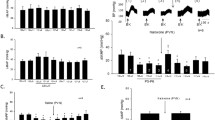Abstract
There exists significant individual variation in electroacupuncture (EA) induced analgesia. Rats may be classified as high- and lowresponders according to their response to EA analgesia. The content of cholecystokinin octapeptide like immunoreactivity (CCK-8-ir) in the spinal perfusate of highresponder (HR) and low-responder (LR) rats was measured with radioimmunoassay. The result showed that the CCK-8-ir content in LR rats was significantly lower than that in HR rats. There exists a negative correlation between the EA effect and the CCK-8-ir content during EA stimulation. It is concluded that the spinal release of CCK-8 may be one of the key factors determining the effect of EA analgesia.
Similar content being viewed by others
References
Fei, H., Xie, G. X., Han, J. S., Low and high frequency electroacupuncture stimulations release (Met5) enkephalin and dynorphin A in rat spinal cord,Kexue Tongbao (in Chinese), 1987, 32(17): 1496.
Zhou, Y., Sun, Y. H., Shen. J. M.et al., Increased release of immunoreactive CCK-8 by electroacupuncture and enhancement of electroacupuncture analgesia by CCK-8 antagonist in rat spinal cord,Neuropept., 1993, 24: 139.
Tang, N. M., Dong, H. W., Wang, X. M.et al., Cholecystokinin antisense RNA increases the analgesic effect induced by electroacupuncture or low dose morphine: conversion of low responder rats into high responders,Pain, 1997, 71: 71.
Stanfa, L., Dikenson, A., Xu, X. J.et al., Cholecystokinin and morphine analgesia: variations on a theme,Trends Pharmacol. Sci., 1994, 15: 65.
Han, J. S., Ding, X. Z., Fan, S. G., Cholecystokinin octapeptide (CCK-8): antagonism to electroacupuncture analgesia and a possible role in electroacupuncture tolerance,Pain, 1986, 27: 101.
Tang, N. M., Dong, H. W., Zhang, L. S.et al., Antisense CCK RNA and CCKB receptor antagonist L365, 260 changed non-responder rat to responder for electroacupuncture analgesia,Chin. J. Pain Med., 1996, 2: 130.
Zhou, Y., Sun, Y. H., Zhang, Z. Q.et al., Increased release of immunoreactive cholecystokinin octapeptide by morphine and potentiation of opioid analgesia by CCK-B receptor antagonist L-365, 260 in rat spinal cord,Eur. J. Pharmacol., 1993, 234: 147.
Ossipov, M. H., Kovelowski, C. J., Vanderah, T.et al., Naltrindole, an opioid delta antagonist, blocks the enhancement of morphine-antinociception induced by a CCK-B antagonist in the rat,Neurosci. Lett., 1994, 181: 9.
Author information
Authors and Affiliations
About this article
Cite this article
Liu, S., Luo, F., Shen, S. et al. Relationship between the analgesic effect of electroacupuncture and CCK-8 content in spinal perfusate in rats. Chin.Sci.Bull. 44, 240–243 (1999). https://doi.org/10.1007/BF02896283
Received:
Issue Date:
DOI: https://doi.org/10.1007/BF02896283



